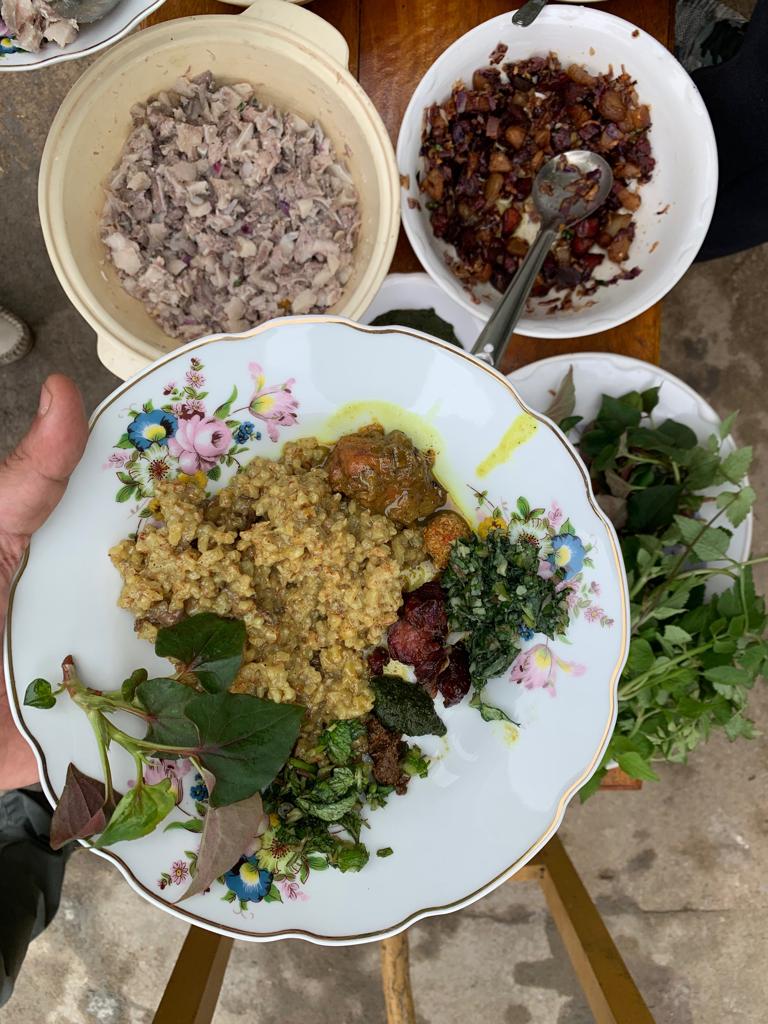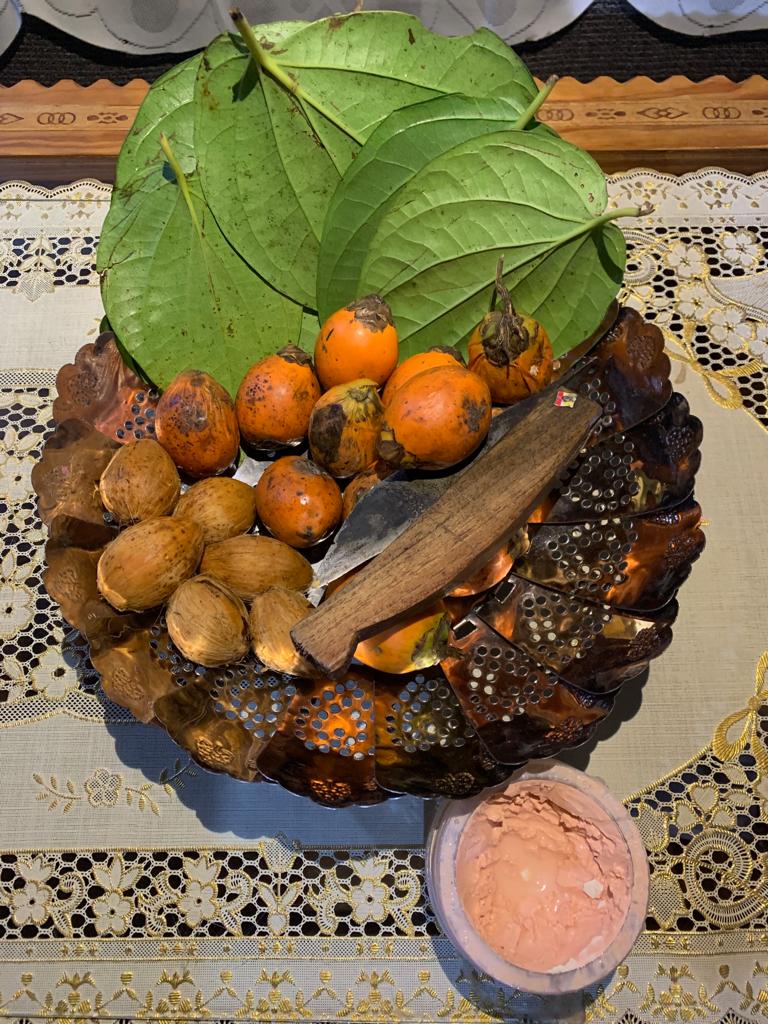
Our curiosity to be a little more familiar with the Khasi cuisine led us to a quaint village called Weiloi, that was 48 km away from the capital city of Shillong, on the Mawsynram Shillong highway. We arrived here with our gracious host Linty who coordinated this insightful culinary visit. We were visiting Linty’s friend Joyfulmary and her lovely family in the village to oversee the preparation of a traditional Khasi lunch and to savour the same. The prospect of having a rustic meal made with local ingredients was so fascinating that we started early from Shillong and after an hour and a half drive we were at our destination.

En route to Weiloi, we stopped at a small village named Trysad for some quick refreshments. There we checked into a tiny roadside eatery, which was full of people having breakfast or just tea. While most of them were sitting on the long benches waiting for their order, few of them were sitting on very low stools and having their food. A couple of agile ladies, dressed in the traditional Khasi attire called Jainkyrshah, were attending to the customers. A pleasantly starchy aroma wafted through the space. We ordered some tea for two reasons. First, we were earnestly craving for it and secondly we were intrigued by the sight of the snacks basket that was being doled out to the customers having this beverage. So on ordering a tea you get a neatly arranged basket full of a delightful assortment of rice cakes and biscuits. After you pick the ones that you like to have, they take it away, to the other customers.
In it we spotted the Pumaloi, Pukhlein, Pusla, sweet bun etc that we had already tried at Iewduh. On Linty’s recommendation, we tried the Pusla, an elongated, leaf-wrapped steamed rice cake that was made from rice flour and jaggery batter. Other than its mild sweetness, there wasn’t anything distinctive about it. In spite of the absence of a robust taste, these rice-based snacks are hugely popular across Meghalaya because of its wholesomeness that sustains the industrious lifestyle of the Khasi people.
Soon we were back on road and after half an hour drive we reached our destination Weiloi. Here we were greeted by the beautiful rustic surrounding and our genial hosts. Since outdoor cooking is common in villages, we spotted the place in the front yard of the house that was spruced up for the cooking session. There was a portable wood fire oven and the necessary utensils.

Before starting with the lunch preparation, we were offered some Putharo(steamed red rice pancakes) with Dohjem(dish made of pork innards). The humble Dohjem was truly delicious. Moreover, the light Putharos impressively complemented its delicious meaty flavours. We also tasted another interesting combination of Pu Syep(rice cake) with sweet milky tea.

Finally, we were out in the front yard to cook two traditional Khasi delicacies named the Jadoh and country chicken curry. Prup, our host, was was ready with all the ingredients. As per the local practice, we would be cooking them on the wood fire. The Jadoh is primarily prepared with pork meat but the chicken variant is also popular. We were making the chicken Jadoh with country chicken meat. During the conversation with Linty, we came to know about a very interesting fact about the chicken meat that is used in the dishes. Generally people use the chicken with its skin for it gives an extra flavour to the meat preparation. They wash the flesh thoroughly and remove all the feathers and then lightly roast it over the fire to soften it. That is how the chicken meat gets ready for cooking.
For the Jadoh Prup, first sliced up some onions and then added them to mustard oil. Then she chopped the chicken into small pieces and kept it aside. When the onions became translucent, she added the chicken to it and after five more minutes she further added the black pepper powder, salt and black sesame seed powder. On a different wood fire oven, she put the red rice to boil. After ten minutes of cooking, she transferred the chicken mixture to the boiling rice and let it simmer on a very low flame till the stock dried up.
The country chicken was also an easy preparation. Chicken pieces were cooked in a simple masala comprising of onions, ginger garlic paste, chillies and salt. After ten minutes of stirring the dry mixture, water was added to it and it was allowed to simmer for some more time till the stock reduced and the meat was tender. In the middle of cooking the intermittent drizzle gave way to a downpour and we had to rush the whole set up to the verandah. It wasn’t much of a surprise as the village Weiloi was nearly 14 km away from the wettest place on the Earth i.e Mawsynram. As we waited for the country chicken to be done, we met the old lady at the house who was wearing the JainTap Moh-a traditional Khasi Shawl-to protect herself from the cold breeze. Together we all had the kwai.

After the cooking was over, without wasting any time we sat down for lunch. Along with the Jado and chicken curry there were few other dishes that the family had already prepared in advance. So our platter comprised of chicken Jadoh, country chicken curry, Phan kleh or potato and herb mash, stir-fried pork, tungtap, mint chutney, pickled sophie and some local herbs.

The star dish Jadoh had a moist texture and was very flavourful. The country chicken curry tasted great as well. We also liked the Phan Kleh or the potato mashed with the local herb Jalangchir. The pickled Sophie needs special mention because it was quite delicious. Along with the regular cooked dishes the locals do eat few herbs that prevents any kind of stomach disorder that might arise due to the consumption of meat. We realised that the use of local ingredients and the traditional style of cooking lifted this humble and minimalist meal to a gratifying experience. After this soul-satisfying meal we had the customary kwai. And soon it was time to bid adieu to the lovely family. Their hospitality was so warm and endearing that it felt like home. Heartfelt thanks to Linty, Sayan, JoyfulMary and her family members for such a heartwarming experience.




